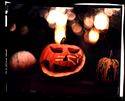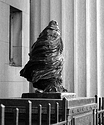Pinholemaster said it. I can calculate the factor and it usually gets me pretty close the first time I test a new paper (although I've standardized lately on Arista grade 2 RC) in a camera. Likewise for film there are equations that predict the reciprocity curve.
If you are interested, here is a quick way (at least to me) to get into the ball park.
1) Know the ISO of the film in your camera. Using, HP5+, then call it ISO 400 (yes, we can argue all day about the real speed but this is just an example). Using Arista Edu.Ultra graded #2 photo paper, then pick ISO 8 as a starting point. Again, with photo paper, they don't have ISO numbers the same way film does, the ISO number you might find in the instruction sheet refers to use with enlargers, not as "film".
2) Meter your scene with your meter or eyeballs calibrated for the "Sunny-16" rule. With pinhole cameras I pretty much go with Sunny-16. So a nicely lit outdoor scene with distinct shadows would be 1/ISO at f/16. 1/400 for my HP5+ or 1/8 for my paper negative.
3) Know the f-stop of your pinhole camera. Focal length / diameter. f/225 in your camera above so lets use that. The magic happens here, base line factor will be:
factor = (fstop camera / fstop meter) ^ 2 or (225 / 16) ^ 2 = 198 (liberally rounded up). The "^" means raise to the power so "^ 2" is squared. -- (225 / 22)^2 = 105 as was already given in your original post.
4) Apply factor, we said 1/400 and 1/8 depending on film choice so that becomes 198 / 400 and 198/8 or 1/2 second for the HP5+ or 25 seconds for the photo paper. Again, I was pretty liberal with the rounding because frankly you won't tell the difference between 24.75 and 25 seconds.

At this point you could be happy and shoot merrily away. It is possible to further correct for reciprocity failures. I do this with film when I get calculated exposures of greater than 1 second, I have made up some charts that I can reference and it seems to be close enough but I also have the full equation to run through too. With photo paper as my negative, I've just fiddled around enough to know that calling the Arista EDU.Ultra #2 ISO 8 is close enough for my developer and printing later. YMMV on that part.
For me, the simplicity comes in the field because I use the Sunny-16 rule for my exposure estimation and I've precomputed the 4 stop range I generally encounter and just have it on a little slip of paper.






